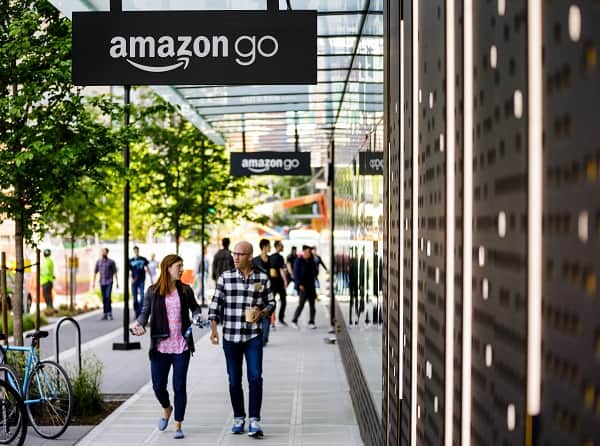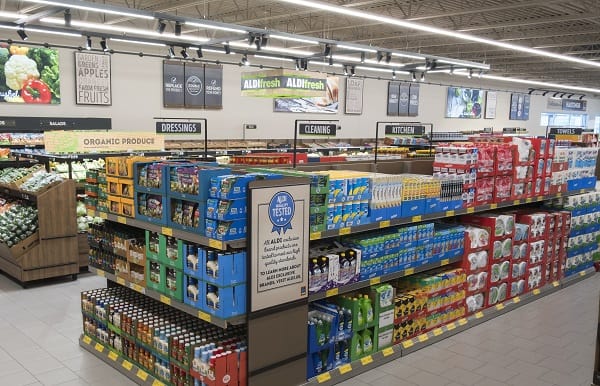If Amazon.com Inc. plans to expand its grocery store footprint aggressively, it’s safe to assume Amazon’s ambitions reach far beyond the scale of its $13.7 billion acquisition of Whole Foods Market in 2017. Amazon wants nothing less than domination of U.S. food sales, analysts say.
“Amazon only enters categories and makes acquisitions that it can scale,” says Brittain Ladd, a former Amazon executive and now a strategy and supply-chain consultant for large grocery store operators. “Amazon didn’t enter the grocery category to only control a small percentage of the $840 billion grocery industry. Amazon wants to become the leader in meeting customer demand for food.”
According to a Friday report in The Wall Street Journal, Amazon plans to launch a grocery chain in Los Angeles as early as the end of 2019 and is in talks to open locations in shopping centers in San Francisco, Seattle, Chicago, Washington D.C. and Philadelphia. Amazon also is looking into acquiring regional grocery chains to help it ramp up the new chain quickly, according to the article. An Amazon spokeswoman declined to comment on the report.
The current state of offline and online food sales
As of now, Amazon dominates online grocery sales. In the first months of 2018, Amazon captured 30% of online grocery spending in the U.S.—as much as all grocery chains combined—according to a May 2018 survey of 4,855 U.S. adults by Brick Meets Click, a consultancy for grocery retailers and the consumer packaged goods industry. But online sales represent a modest sliver of the overall grocery market, which stores dominate.
Online sales represented just 5.5% of U.S. grocery sales in 2018, Brick Meets Click says. In 2019, the firm expects it to grow to 6.3%. In the vastly larger world of store-based sales, Walmart Inc. is the clear leader. Euromonitor International Ltd. says Walmart’s 2018 market share of store-based grocery sales was 25.9%, Whole Foods’ market share is estimated by other sources to be about 2%.
Competition from Amazon has been “one of the big motivators of retailers to get into ecommerce,” says Bill Bishop, chief architect at Brick Meets Click. The expansion of its store presence is a solid indication that Amazon now wants to be an omnichannel retailer to challenge traditional retailers in the physical world.
“This is the third shoe to hit the floor,” Bishop says, following Amazon’s Whole Foods acquisition and the 2018 launch of Amazon Go, a chain of cashier-less convenience stores that sell sandwiches, beverages, snacks and other items.
“Amazon’s forays into online grocery sales so far have yielded mixed results, and traditional grocery retailers like Kroger have significantly stepped up their own investments in ecommerce,” says Amanda Bourlier, a consultant at market research provider Euromonitor International Ltd.
How Amazon could become a major grocery player
If reports about Amazon opening a new grocery chain are accurate, that development “would lend further credence to the idea that well-designed, well-located brick-and-mortar stores have an important role to play in the years ahead, even as ecommerce continues to grow,” Bourlier says.
Reports say Amazon wants to open 3,000 Amazon Go locations by 2021, but so far there are 10—four each in Chicago and Seattle and two in San Francisco. The much-larger Whole Foods chain operates 479 stores in North America. Compared to the grocery leaders, that is a modest presence.

Amazon reportedly wants to open 3,000 Amazon Go convenience stores by 2021. So far, it has opened 10. (Amazon photo)
Walmart, America’s largest grocer, operates 4,750 grocery stores nationwide. Kroger Co., the second-biggest U.S. grocery retailer, has about 2,800 grocery stores in 35 states, and third-ranked Albertsons Cos. Inc. runs roughly 2,300 retail food and drug stores in 35 states and the District of Columbia.
To realize its ambitions in the grocery market, Amazon must dramatically increase its store footprint, Ladd says. To become the nation’s food retailing leader Amazon (No. 1 in the Internet Retailer 2018 Top 1000), needs a significant presence in the grocery business, which means directly challenging Walmart Inc. (No. 3) and Kroger (No. 86). And doing that requires opening more grocery stores, Ladd says.
“I conducted research at Deloitte and Amazon and based on the results of the analysis, Amazon must operate a minimum of 2,150 grocery stores in order to take market share in groceries from Kroger and Walmart,” Ladd says.
If Amazon opens that number of stores, its grocery sales could exceed those of Kroger during the period from 2027 to 2030, Ladd says. And during the period from 2030 to 2035 Amazon’s grocery sales could exceed those of Walmart.
“Amazon doesn’t have to have the same number of stores like Kroger or Walmart as Amazon has a better value proposition it can offer customers,” Ladd says.
Amazon’s best option would be to acquire Target Corp. (No. 17)—which operates 1,850 stores in the United States and is already a significant grocery retailer—and open Amazon grocery stores inside Target stores, Ladd says. But that is not Amazon’s only path. For example, Amazon could acquire Sprouts Farmers Markets Inc., a chain of more than 300 stores in 19 states that specializes in natural and organic products, along with small regional chains that it could then rebrand. Also, Amazon could lease available real estate and empty stores.
“Based on my research, Amazon can reach 2,150 stores by 2023 to 2025 depending on the strategy they pursue. Make no mistake, stores matter in grocery retailing and Amazon will be at a disadvantage if it doesn’t achieve a nationwide presence,” Ladd says.
“I’m not advocating Amazon copy Walmart, Kroger or any other grocery retailer,” Ladd says. Instead, he thinks Amazon should re-imagine grocery retailing and leverage stores to create something more than just a trip for groceries.
“Yes, online sales of groceries are increasing but so too are consumer trends that can best be served through stores—especially personalized meals and cooked food. Building stores isn’t a step-back for Amazon; it’s a way for Amazon to give consumers choices,” he says.
Why does Amazon want to be in the grocery market?
But why does Amazon want to tackle groceries—a notoriously low-margin retail category—in the first place?
“Grocery shopping is ubiquitous,” Bishop says. Because every household buys food, a grocery infrastructure offers Amazon the chance to build a relationship with consumers that could lead to additional sales of products and services, he says.
Ladd agrees. “Consumers purchase groceries and food more than anything else. Amazon understands that if they can establish a leadership position in groceries—even though it is a low-margin business—Amazon will attract more customers to buy its higher margin products sold online,” he says.
Beyond that, opening grocery stores is part of becoming “omnipresent in the lives of consumers,” Ladd says. That means building a presence in sectors like food and groceries, insurance, pharmacy, healthcare and entertainment and others.
“Amazon understands that companies fail when they lose relevance. By creating new services and entering into new categories, Amazon will always be relevant,” Ladd says.
As Amazon moves forward in the grocery store business, other retailers should not waste time preparing for the competition in small and large ways, Bishop and Ladd say.
“What they have to do is reduce their costs to serve their customers. They have to do that significantly,” Bishop says. He says grocery retailers can use strategies that do not directly affect customers, such as changing how products are displayed in stores and using smarter inventory control to reduce the amount of working capital tied up in goods on shelves and in stockrooms.

Aldi saves labor costs by putting entire cases of merchandise on shelves, rather than unpacking the cases and placing items on shelves individually. (Aldi photo)
A good merchandising example to follow, he says is the method used by Aldi, a German discount grocery chain that operates more than 1,800 U.S. stores in 35 states. That chain saves labor costs, he says, by putting entire cases of merchandise on shelves, rather than unpacking the cases and placing items on shelves individually.
It also is time for grocery retailers to make big, strategic moves, Ladd says. His suggestions include a merger of Kroger and Target or Kroger and Ahold-Delhaize (No. 62), which operates about 2,000 stores and distribution centers across 23 states. Another option would be for Costco to acquire Kroger, he says.
“Walmart has a tremendous advantage in groceries because of the large number of stores it operates. Walmart’s online efforts are certainly important. However, I believe stores are Walmart’s overwhelming competitive advantage. I believe Walmart should assess acquiring a home-improvement retailer—Lowe’s Cos. (No. 21) or Menards Inc. (no. 224) are who I recommend—to increase its stores’ advantage,” Ladd says.
Ladd also thinks Walmart should increase the number of convenience stores it opens and integrate groceries and grocery pickup into those stores.
“Groceries are like nuclear weapons for Walmart and it’s an arms race Walmart must win. If Amazon becomes larger than Kroger by grocery sales—something Amazon can easily do—Walmart will eventually fall. Walmart has to do everything in its power in the present to prevent Amazon from becoming a threat in the future,” Ladd says.
For the fourth quarter ended Dec. 31, Amazon’s sales at its physical stores—which includes Whole Foods, Amazon Bookstores, Amazon Go, etc.—generated $4.40 billion, down 2.75% from $4.52 billion in the comparable period. Amazon Chief Financial Officer Brian Olsalvsky attributed to the decline to how Amazon accounted for Whole Foods in Q4 2017. Olsalvsky said Q4 a year ago included five more days of Whole Foods revenue. He also noted that Whole Foods sales made online via Prime Now are accounted for in Amazon’s online sales, not store revenue.
Favorite